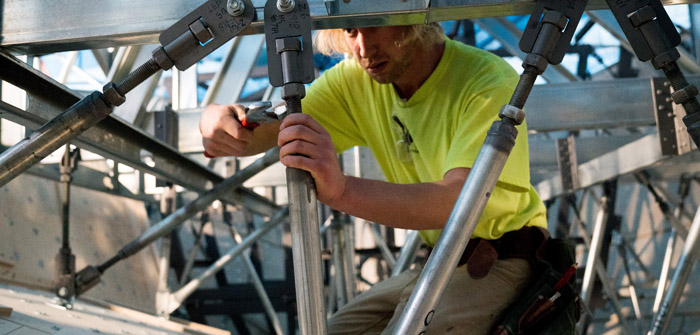(Photo | Courtesy of Entre-Prises)
Manufacturing is alive and well in Central Oregon. Although the industry may have changed in the past three decades, there are a multitude of companies setting up shop here, and there are entities around the state working to grow this sector of business in the region.
“Manufacturing in Central Oregon has almost never been stronger,” said Roger Lee, CEO of Economic Development for Central Oregon (EDCO). “Visitors come here to recreate and play, but what’s happening in the manufacturing sector tells a completely different story.”
Manufacturing is defined in the dictionaries as “The making of articles on a large scale using machinery; industrial production. The process of converting raw materials, components or parts into finished goods that meet a customer’s expectations or specifications. Manufacturing commonly employs a man-machine setup with division of labor in a large-scale production. Manufacturing is the production of products for use or sale using labor and machines, tools, chemical and biological processing or formulation. Most manufacturing environments fit into one of five general categories: Repetitive, Discrete, Job Shop, Process (batch) and Process (continuous). Most companies use more than one of these environments to get a single product out the door.”
Lee said that whereas Central Oregon used to have a few large manufacturing companies with hundreds of employees each, that landscape has changed. Now, manufacturing here comprises lots of smaller companies. “For example, 20 and 30 years ago, wood products, mills, boats and motor coaches were big industries here. But they have been replaced by a bunch of smaller companies,” he said. “This is better, because there are so many more of these smaller companies. If one takes a downturn, they don’t all get hit.” He added, “When one goes, 20 fill its place. I’m thinking we are pretty close to an apex right now.”
Manufacturing in Central Oregon runs the gamut. Industries that call this area home range from auto parts and aviation supplies to construction or housing materials, medical and beauty supplies and a range of items serving the food and beverage industry. There are companies that produce athletic equipment, heating and cooling supplies, bio-ag materials, computer and tech parts and products serving the entertainment industry. And then of course there are the growing hemp and cannabis industries.
EDCO conducted a study on manufacturing employment and payroll growth between 2010 and 2018 and found that Central Oregon has significantly outpaced the nation and state (both of which have had solid gains) over the past eight years both in job growth and overall wage gains. “We blow away statewide averages in the region,” said Lee.
The primary challenge that comes with explosive growth, Lee said, is the ability to attract and retain the talent needed to keep up with the demand. “Unemployment rates are historically low here, but the skill sets are not necessarily aligning with what employers are looking for,” he said. However, Lee said this is not the case with all industries. “We have folks who say the skill and talent they are getting is phenomenal.”
Entre-Prises, a pioneer company in the climbing wall industry that designs, manufactures and installs custom products throughout the world, has its U.S. headquarters in Bend. Entre-Prises was started in 1985 by climber François Savigny at Saint Vincent de Mercuze, France, and by 1988, the company had grown enough that a U.S. headquarters was established.
“Sport climbing came from Europe and was taking off in the U.S.,” said Sander Culliton, president, CEO and sales director of Entre-Prises in Oregon. “The main motivation in setting up in Bend was Smith Rock.”
Culliton, who has lived in Bend for 20 years, said being headquartered here has been “wonderful for the most part. It’s great for those of us who work here, because the vast majority of us are very outdoor-oriented. We feel lucky.”
He agrees with Lee in that one of the challenges of manufacturing in Central Oregon is in recruiting talent, as are logistics such as travel, shipping, obtaining raw industrial materials and processes and finding affordable space. Because Bend is a smaller town, there are some limitations on what is available here. When that happens, Entre-Prises goes to Portland to conduct business.
“You can’t just get on an airplane and go anywhere from here,” he said. “Being an outdoor company in Bend is a bit of a double-edged sword. It’s good on the one hand, but the cost of living is somewhat expensive, and the wages aren’t high. That helps us with costs because we aren’t as big as some of the other industries like construction, but it’s a challenge in attracting talent.” Entre-Prises currently has 56 employees, Culliton said, and the company is always looking for new talent. “We have certain positions we look for year-round.”
Despite the challenges, Culliton said he believes the future of manufacturing in Central Oregon is bright. In the past 20 years, he said the biggest change in the industry he’s seen is the growth in the region, and as a result, some of the previous challenges in manufacturing here have improved.
“Manufacturing in Central Oregon is a group we are proud to be a part of. The outdoor industry has been recognized as a big income-producer in the state. That helps a lot. We have more individual associations and politicians who are taking time to ask us what is needed.” He continued, “Having a university in town also helps. There will be more trained individuals here now, so we won’t have to recruit from outside areas.” He said the automation of the industry has presented new struggles in that it requires trained operators, but that now, programs are in place to train people right here in Central Oregon. “Even Redmond High School has some really good trade programs. That has helped a lot.”
The Redmond High curriculum includes classes in welding, computer-aided drafting, computer-integrated manufacturing and student leadership skills. At OSU-Cascades, computer science and software engineering classes are offered, along with courses in energy systems engineering arts, media and technology. Other agencies have also recognized the need to help fill those vacant slots in manufacturing companies, and are offering ways to help those companies thrive.
The State of Oregon Employment Department projects that the manufacturing sector in Oregon will grow by 11.1 percent between 2012 and 2022. In its Employment in Central Oregon: August 2019 release, the ED reported there were 5,740 manufacturing employees (non-farm) in Deschutes County, 720 in Crook County and 1,280 in Jefferson County. To help facilitate that growth, the ED offers the Oregon Apprenticeship Initiative in Manufacturing (AIM) program. AIM exists to help Oregon employers create and expand manufacturing apprenticeship programs for a large range of skilled manufacturing professions. Assisted by a $3 million-dollar federal grant, the agency can offer employers up to $10,000 per apprentice to help offset the costs associated with starting a new registered apprenticeship program. (For more information about AIM, call 503-931-5379 or email shaun.c.engstrom@oregon.gov).
The Manufacturing Extension Partnership (OMEP), is a state-sponsored consulting organization that works side by side with Oregon manufacturers to help build successful businesses. It sends consultants into manufacturing companies to help problem-solve, eliminate obstacles and streamline. Based in Portland, OMEP has a regional office in Bend.
EDCO is also a driving force in helping to grow manufacturing in the region. Founded in 1981, EDCO is a nonprofit with a mission to create a diversified local economy and a strong base of middle-class jobs in Central Oregon. With its stated mission of “move start grow,” EDCO works to help companies attract and guide outside employers in relocating to the region; mentors and advises scalable young companies from concept to exit on issues such as access to capital, critical expertise and strategy; and partners with local traded-sector companies to help them grow and expand.
In Jefferson County, an initiative has been launched to attract more business to the area through grant funds toward the construction of industrial warehouse space for potential larger tenants. Under the program, qualified entities could receive up to $143,000 to build structures, which could draw new manufacturing companies into the region.
All of these programs bode well for continued growth in Central Oregon’s manufacturing arena. “I believe we will continue to be strong in manufacturing, with many additional smaller companies coming in,” said Lee. “Our population growth numbers are still top in the nation. We are positioned to help attract more companies.”




